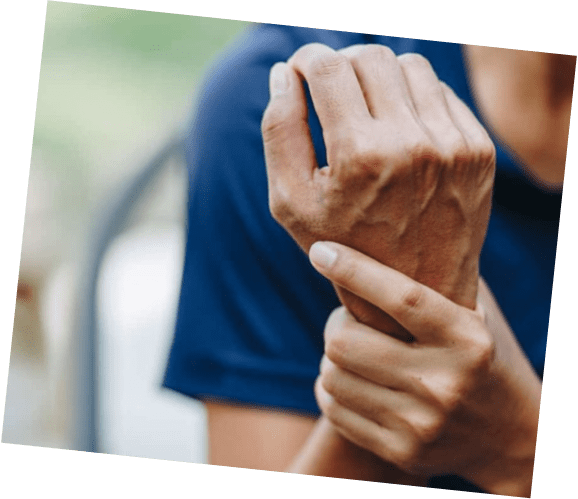Hand & Wrist
Dr David Bradshaw has advanced, sub-specialty training in hand and wrist surgical procedures including arthroscopic (keyhole) surgery, reconstructive surgery and arthritis-related surgery.

Dr David Bradshaw has advanced specialist training in hand and wrist surgical procedures including arthroscopic (keyhole) surgery, reconstructive surgery and arthritis-related surgery.
Dr David Bradshaw provides a comprehensive hand surgery practice.
Depending on the type and severity of your hand/wrist injury, surgery might be the best option. Dr Bradshaw specialises in minimally invasive arthroscopic (key-hole) surgery. His aim is to get you the best possible outcome, taking into account your lifestyle, general health and family situation.
Before surgery, Dr Bradshaw will guide you through the process and address any concerns you have.
Common Hand & Wrist Issues
Medical Conditions
- Arthritis of the hand and wrist
- Carpal tunnel syndrome
- Cubital tunnel syndrome
- Other peripheral nerve disorders
- Dupuytren’s contracture
- Trigger digit
- De Quervains syndrome
Acute Injuries
- Fractures and dislocations
- Tendon injuries
- Nerve Injuries
- Ligament injuries

Patient Information
Dressing
A dressing has been applied to your wound. The area under your dressing is sterile and should not be disturbed before your next follow-up appointment. You should AVOID baths and direct water from showering that may wet your dressing and your wound. If you are showering and have a splint, cover your splint with a clean, new plastic garbage bag and tape it closed at the end to keep your dressing dry. Bathing is often easiest with the arm held above the water out of the bath. If you only have a water resistant transparent dressing in place, showering can occur without the need for a plastic bag coverage. Take care to avoid direct water onto your dressing that can get under the dressing and potentially compromise the dressing’s sterility and hold (leading to lifting of the dressing).
Plaster
A plaster is sometimes applied to your hand and wrist, depending on the procedure you have had and whether there is a need to stabilise a joint or protect a repair. When indicated, a splint helps protect your wound and restrict movement that can increase your pain and swelling. If this is not the case, you have had minor surgery that does not require splinting.
Problems that should be reported to my office
Bleeding through or around your bandage.
Wound: An oozing wound longer than 7 days is unusual, especially if associated with a fever.
Pain: Any significant, sudden increase in pain that is out of proportion to your expected recovery.
Follow-up
Your first follow-up appointment is normally scheduled for 2 weeks with our practice nurse. A second follow- up is normally scheduled for 4-6 weeks later, depending on the surgery that has been performed.
Pain
Some degree of discomfort is normal after surgery, but you should not have to ‘put up’ with pain. You will be given painkillers and sometimes anti-inflammatories for your pain. Strong pain medications can be tapered over a few weeks. Significant pain normally resolves within 2 weeks. Some pain can last up to 6 weeks and continues to improve each day.
There are several steps you can take to help control (but not eliminate) your pain:
- Take your pain medications as prescribed on the bottle. As your pain level improves, decrease the dose, rather than increasing the time between doses. For example, start with 2 tablets and decrease to 1 tablet, then 1⁄2 a tablet every 4 hours as your pain level decreases. This will control your pain better than waiting until your pain is worse before taking the tablet.
- At night, consider setting an alarm when you go to bed, so that you take your scheduled dose during the night. This will help control your pain and prevent unexpected early morning wakening as your pain medications wear off.
- An ice pack (or ice cubes in a plastic bag), wrapped in a tea towel can be applied to the hand for 20 minutes. Do not allow the ice to dampen or wet the dressing. You should AVOID removing the dressing to apply ice directly to the skin. The area under your dressing is sterile and should not be disturbed before your next follow-up appointment. Ice therapy can be discontinued after the first 3 days.
- Fluid tends to accumulate in the hands, forearm and elbow in an operated limb. This is a normal response of your body to surgery. Do not be alarmed if your fingers and hand swell. They may also turn purple if fluid and blood accumulate in your soft tissue. To control some of the fluid accumulation, try and elevate your hand while you are resting, aiming for your wrist/hand to be higher than your heart. Less swelling is often associated with less “throbbing” pain and can be an effective way of controlling some of your pain.
You may experience side effects from the anaesthetic or pain medications. The most common are nausea and constipation. Over-the-counter medications can minimize these side-effects and are available at your local pharmacy. Ask your pharmacist for help, if you have questions.
Dressing
A dressing has been applied to your wound. The area under your dressing is sterile and should not be disturbed before your next follow-up appointment. Fortunately, problems with dressings are exceptionally rare unless you disturb or remove your dressing. You should AVOID baths and direct water from showering that may wet your dressing and your wound. If you are showering and have a splint, cover your splint with a clean, new plastic garbage bag and tape it closed at the end to keep your dressing dry. Bathing is often easiest with the arm held above the water out of the bath. If you only have a water resistant transparent dressing in place, showering can occur without the need for a plastic bag coverage. Take care to avoid direct water onto your dressing that can get under the dressing and potentially compromise the dressing’s sterility and hold (leading to lifting of the dressing).
Plaster
A plaster is sometimes applied to your wrist, depending on the procedure you have had and whether there is a need to stabilise a joint or protect a repair. When indicated, a splint helps protect your wound and restrict movement that can increase your pain and swelling. If this is not the case, you have had minor surgery that does not require splinting.
Problems that should be reported to my office
Bleeding through or around your bandage. Dry blood staining of your dressing without blood pooling or lifting of the dressing is normal and expected. If you are unsure, please contact our office in preference to changing your dressing yourself.
Wound: An oozing wound longer than 7 days is unusual, especially if associated with a fever.
Pain: Any significant, sudden increase in pain that is out of proportion to your expected recovery.
Follow-up
Your first follow-up appointment is normally scheduled for 2 weeks with our practice nurse. A second follow- up is normally scheduled for 4-6 weeks later, depending on the surgery that has been performed.
Pain
Some degree of discomfort is normal after surgery, but you should not have to ‘put up’ with pain. You will be given painkillers and sometimes anti-inflammatories for your pain. Strong pain medications can be tapered over a few weeks. Significant pain normally resolves within 2 weeks. Some pain can last up to 6 weeks and continues to improve each day.
There are several steps you can take to help control (but not eliminate) your pain:
- Take your pain medications as prescribed on the bottle. As your pain level improves, decrease the dose, rather than increasing the time between doses. For example, start with 2 tablets and decrease to 1 tablet, then 1⁄2 a tablet every 4 hours as your pain level decreases. This will control your pain better than waiting until your pain is worse before taking the tablet.
- At night, consider setting an alarm when you go to bed, so that you take your scheduled dose during the night. This will help control your pain and prevent unexpected early morning wakening as your pain medications wear off.
- An ice pack (or ice cubes in a plastic bag), wrapped in a tea towel can be applied to the wrist for 20 minutes. Do not allow the ice to dampen or wet the dressing. You should AVOID removing the dressing to apply ice directly to the skin. The area under your dressing is sterile and should not be disturbed before your next follow-up appointment. Ice therapy can be discontinued after the first 3 days.
- Fluid tends to accumulate in the hands, forearm and elbow in an operated limb. This is a normal response of your body to surgery. Do not be alarmed if your fingers and hand swell. They may also turn purple if fluid and blood accumulate in your soft tissue. To control some of the fluid accumulation, try and elevate your hand while you are resting, aiming for your wrist/hand to be higher than your heart. Less swelling is often associated with less “throbbing” pain and can be an effective way of controlling some of your pain.
You may experience side effects from the anaesthetic or pain medications. The most common are nausea and constipation. Over-the-counter medications can minimize these side-effects and are available at your local pharmacy. Ask your pharmacist for help, if you have questions.

Dr David Bradshaw is a Sydney-trained specialist orthopaedic surgeon with advanced training in hand and wrist surgery.
Dr Bradshaw aims to provide high level, accessible and timely expertise to the Greater Sydney and Central Coast regions. He is a consultant hand and microsurgeon in the South Western Sydney Hand Centre, a major tertiary-referral metropolitan hand unit, where he performs major and complex reconstructive procedures for severe hand injuries.
Contact Us
If you have a question or wish to make a booking, please contact us to find a convenient time and date. A GP referral is required.